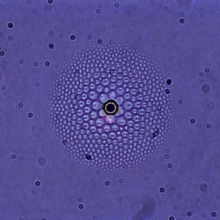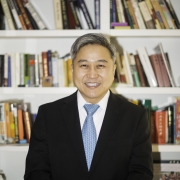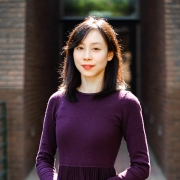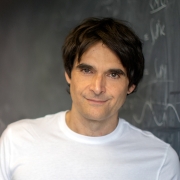Team Led By Randall Kamien Advances Nanotechnology Through Liquid Crystal Construction

A team of material scientists, chemical engineers, and physicists from the University of Pennsylvania has made another advance in its effort to use liquid crystals as a medium for assembling structures.
It is an example of a growing field of nanotechnology known as “directed assembly,” in which scientists and engineers aim to manufacture structures on the smallest scales without having to individually manipulate each component. Rather, they set out precisely defined starting conditions and let the physics and chemistry that govern those components do the rest.
In their earlier studies, the team produced patterns of “defects,” useful disruptions in the repeating patterns found in liquid crystals, in nanoscale grids and rings. The new study adds a more complex pattern out of an even simpler template: a three-dimensional array in the shape of a flower. Because the petals of this “flower” are made of transparent liquid crystal and radiate out in a circle from a central point, the ensemble resembles a compound eye and can thus be used as a lens.
The team consists of Randall Kamien, Vicki and William Abrams Professor in the Natural Sciences in physics and astronomy; Kathleen Stebe, the School of Engineering and Applied Science’s deputy dean for research and professor in chemical and biomolecular engineering; and Shu Yang, professor in Engineering’s Departments of Materials Science and Engineering and Chemical and Biomolecular Engineering. Members of their labs also contributed to the new study, including lead author Daniel Beller, Mohamed Gharbi, and Apiradee Honglawan.
When the researchers planted silica beads—polished grains of sand—at the top of a pool of liquid crystal, flower-like patterns of defects grew around each bead. In earlier experiments with different materials, the interface was flat. Here, surface tension on the bead allows the 'petals' to be arranged in a tiered, convex fashion. Because the liquid crystal can interact with light, the entire assembly can function as a lens, focusing light to a point underneath the bead, as with an insect’s compound eye or the mirrors on large telescopes. This type of directed assembly could be useful in making optical switches and in other applications.
Their work was published in Physical Review X and supported by the National Science Foundation, Penn’s Materials Science Research and Engineering Center, and the Simons Foundation.
Read the full story here.





